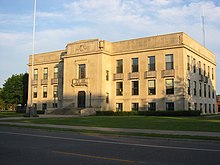Mille Lacs County, Minnesota
Mille Lacs County | |
|---|---|
 Location within the U.S. state of Minnesota | |
 Minnesota's location within the U.S. | |
| Coordinates: 45°56′N 93°38′W / 45.93°N 93.63°W | |
| Country | |
| State | |
| Founded | May 23, 1857 [1] |
| Named for | Mille Lacs Lake |
| Seat | Milaca |
| Largest city | Princeton |
| Area | |
| • Total | 682 sq mi (1,766 km2) |
| • Land | 574 sq mi (1,488 km2) |
| • Water | 107 sq mi (278 km2) 15.74% |
| Population (2000) | |
| • Total | 22,330 |
| • Density | 39/sq mi (15/km2) |
| Time zone | UTC−6 (Central) |
| • Summer (DST) | UTC−5 (CDT) |
| Website | www |
Mille Lacs County is a county located in the U.S. state of Minnesota, founded in 1857[2]. As of 2000, the population was 22,330. Its county seat is MilacaTemplate:GR. A portion of the Mille Lacs Indian Reservation is in the county.
Name
The name Mille Lacs, meaning "thousand lakes" in French, comes from Mille Lacs Lake (French: Grand lac du Pays de Mille Lacs), largest lake in the Brainerd Lakes Area as the area was called "Region of Thousand Lakes" (Pays de Mille Lacs) in French.[3]
History
Mille Lacs County was organized on May 23, 1857 cleaving off the eastern-most portion of Benton County, Minnesota. The original Mille Lacs County consisted of the portion of the contemporary Mille Lacs County east of the west branch of the Rum River and two townships now part of Isanti County, adjacent to Mille Lacs County. In 1858, the 12 townships forming the contemporary southern 10 townships of Mille Lacs County and the 2 northwestern townships in Isanti County were organized apart from either Benton or Mille Lacs County to form Monroe County, leaving the northern "Square Top-knot" as the Mille Lacs County. In 1860, Monroe and Mille Lacs Counties merged. Shortly thereafter, the two southeastern townships were transferred to Isanti County, forming the contemporary boundaries for the county.
Geography
According to the U.S. Census Bureau, the county has a total area of 682 square miles (1,766 km²), of which 574 square miles (1,488 km²) is land and 107 square miles (278 km²) (15.74%) is water. Agriculture is in the western and southern parts of this county. The forest's and recreation are the most important land uses in the eastern part. There are large areas in eastern Pine County that are still heavily forested and untouched, although there are no large white pine stands still to this day. There are 5 rivers that flow through the county: the St. Croix, Kettle, Snake, Rum, and Ripple rivers. The drainage system is still being built, leading to wetland areas. There are 12 lakes in the county of Mille Lacs: Anderson, black bass, cranberry, fog, mille lacs, mud, rice, shokope, sliver, tamarac, warren, and whitefish.
Major highways
Adjacent counties
- Aitkin County (north)
- Kanabec County (northeast)
- Isanti County (southeast)
- Sherburne County (south)
- Benton County (southwest)
- Morrison County (west)
- Crow Wing County (northwest)
National protected area
Demographics

As of the censusTemplate:GR of 2000, there were 22,330 people, 8,638 households, and 6,003 families residing in the county. The population density was 39 people per square mile (15/km²). There were 10,467 housing units at an average density of 18 per square mile (7/km²). The racial makeup of the county was 93.55% White, 0.27% Black or African American, 4.68% Native American, 0.21% Asian, 0.01% Pacific Islander, 0.22% from other races, and 1.05% from two or more races. 0.96% of the population were Hispanic or Latino of any race. 31.9% were of German, 14.4% Swedish and 14.2% Norwegian ancestry according to Census 2000.
There were 8,638 households out of which 32.20% had children under the age of 18 living with them, 55.50% were married couples living together, 9.50% had a female householder with no husband present, and 30.50% were non-families. 25.90% of all households were made up of individuals and 12.00% had someone living alone who was 65 years of age or older. The average household size was 2.53 and the average family size was 3.03.
In the county the population was spread out with 27.00% under the age of 18, 7.50% from 18 to 24, 26.90% from 25 to 44, 22.60% from 45 to 64, and 16.10% who were 65 years of age or older. The median age was 38 years. For every 100 females there were 98.00 males. For every 100 females age 18 and over, there were 96.10 males.
The median income for a household in the county was $36,977, and the median income for a family was $44,054. Males had a median income of $32,348 versus $22,036 for females. The per capita income for the county was $17,656. About 6.70% of families and 9.60% of the population were below the poverty line, including 10.90% of those under age 18 and 11.30% of those age 65 or over.
Cities and towns

| Cities | Townships | Unincorporated communities | |
|---|---|---|---|
| |||
† a small part of Princeton extends into Sherburne County.
References
- ^ Minnesota Government Series, State Symbols
- ^ Minnesota House of Representatives
- ^ Upham, Warren. (1920; repr. 1991)Minnesota Place Names St. Paul: Minnesota Historical Society Press.

